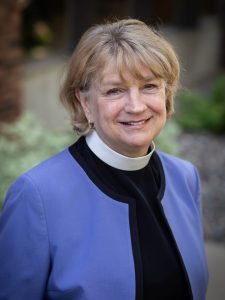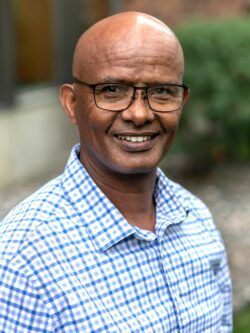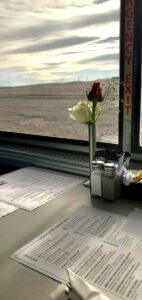Created to be
January 30th, 2024 By Pastor John Hulden
By Pastor John Hulden

Pastor Rusty Halaas (white suit jacket) on the stage of the youth gathering in Madison Square Garden in New York City in 1970.
Imagine you were given the task of dreaming up themes for a five-day event for 15,000 teenagers at a triennial ELCA Youth Gathering. Where would you turn in the scriptures? What phrase could work to grab and hold the attention of high school youth? Would they choose to wear that theme on T-shirts, water bottles, fanny packs, and more?
Thanks to my dad (Pastor Rusty Halaas, 1926-2018), I’ve been involved in these life-changing faith formation gatherings for teenagers before I was a teenager. I got to tag along in 1967 to the American Lutheran Church youth gathering in Seattle when I was seven years old – and have been to more than a dozen gatherings since. (Before I was born, my dad was the host pastor and planner for the 1957 Evangelical Lutheran Church (ELC) Luther League convention in Missoula, Montana.)*
I wasn’t surprised when a recent study showed that the “Big 4” influencers for faith formation in the ELCA are Sunday school, summer camp, campus ministry, and the triennial Youth Gathering.
WHO HELPED TO FORM your faith? My most influential Sunday school teacher, Vic Acklund at Bethel Ev. Lutheran in South Minneapolis, taught me about grace. I’ve lost count on the number of Lutheran Bible camps I’ve visited. I also served on the board of Pathways in Northwest Minnesota. When I attended Concordia College in Moorhead, there were two campus pastors, the Revs. Carl Lee and Ernie Mancini. They both knew my name and pointed out my gifts for leadership and ministry. (And as you might imagine, I can bore you with way too many youth gathering stories.)

Event booklets from old Lutheran youth gatherings
Did you notice that only one of the “Big 4” is done exclusively in the congregation? We need to work together to support outdoor ministry experiences, campus ministry pastors, as well as the biggest faith formation event the ELCA hosts every three years.
Last week I was in New Orleans to hear all about this summer’s ELCA Youth Gathering. There is still time to find a teenager or two and sign up and take them. I can give congregations who have yet to register the lowest rate – if you register before February 14. Please connect with me soon if you haven’t signed up for the youth gathering yet! Scroll down to see the blurbs about the events from the synod’s enews.
“Did you notice that only one of the ‘Big 4’ faith formation events is done exclusively in the congregation?”
And, about those five themes: The almost all-volunteer run 2024 Youth Gathering has chosen five themes for five days in a row this summer. Psalm 139 is the scripture foundation: “O Lord, you have searched me and know me. … I am fearfully and wonderfully made, … [so] get a clear picture of what I’m about; then guide me on the road to eternal life.” (mashup of NRSV and “The Message”)
Created to Be BRAVE – You Are Not Alone
Created to Be AUTHENTIC – You Are Seen
Created to Be FREE – You Are Loved
Created to Be DISRUPTIVE – You Are Called
Created to Be DISCIPLES – You Are Sent
I am so looking forward to this summer in New Orleans, and I can’t wait to add a “Created to Be” T-Shirt to my gathering collection. But there will be no fanny pack for me.
*You can view a 30-minute silent movie of the 1957 ELC Luther League gathering in Missoula, Montana. The theme in 1957 was “Built on a Rock.” Westwood Lutheran, St. Louis Park, Minnesota, was there with a banner (@ 19:14). My 31-year-old pastor-Dad is present in his red western shirt at the BBQ (@ 15:35) and is speaking to the crowd at the rodeo arena (@ 22:36). In 1957 the gatherings didn’t use hotels; instead, the Lutheran churches in Missoula arranged home stays for the thousands of teenagers and their adult leaders. A list of previous Lutheran youth gatherings in the US dating back to 1895 is also available.



 By Mercy Zou Taithul
By Mercy Zou Taithul 
 By Manny Lewis
By Manny Lewis
 By Bob Hulteen
By Bob Hulteen 

 By Bishop Ann Svennungsen
By Bishop Ann Svennungsen 

 By Jeni Huff
By Jeni Huff
 And
And
 By Pastor Wondimu Sonnesa
By Pastor Wondimu Sonnesa  By Pastor John Hulden
By Pastor John Hulden 





 By Johan Baumeister
By Johan Baumeister
